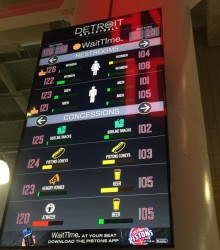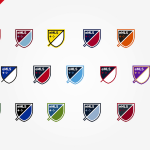WaitTime Screens Are Now Live at the Palace and in Pistons App

Basketball fans in Michigan haven’t had much to cheer about lately. The Detroit Pistons are battling for an NBA playoff spot despite being ranked eighth in the Eastern Conference, and we won’t even mention what happened at the NCAA tournament a few weeks ago. However, Motor City startup WaitTime is trying to add a little light to hoops fans’ lives by helping them find the shortest beer and bathroom lines in the stadium.
WaitTime is a crowd-science and artificial-intelligence technology company that launched in 2013. After a stint at the now-defunct Bizdom accelerator, a pivot, and some beta testing, WaitTime’s proprietary imaging software has now been unleashed at the Pistons’ home court, the Palace of Auburn Hills. CEO Zach Kilma described it as the first “full stadium installation” of his company’s technology, thanks to a partnership with the Pistons.
Those attending Pistons games can now look up at one of 30 large screens posted around the Palace for real-time information about how long the lines are at the stadium’s various concession stands and restrooms. It’s the first AI-based software of its kind to hit the market anywhere in the world, Klima said, and it’s capable of analyzing images to accurately determine how many people are in line and how fast the lines are moving, which alleviates congestion. Line attrition, when people give up and go back to their seats, is another key data point the software tracks.
“Line attrition is very important because concessionaires view it as lost revenue,” Klima said. “It’s something they’ve been trying to track for 30 years, and now we have the ability to do so.”
Klima said WaitTime makes its money by offering these insights to a stadium’s concessions operators and selling ad space on the screens posting WaitTime’s information, but its mission is also to enhance the fan experience. Detroit Pistons mobile-app users can also look up real-time line information on their phones from their stadium seats. “We’re trying to cater to all generations no matter how much technology experience they have,” he added. “If someone is tech averse, they can just look up at the signs.”
WaitTime has an unusual corporate structure is unusual. Rather than pursuing traditional investment rounds, the company instead assembled a team of 17 “internal funders”—many of whom hold leadership positions at large corporations—to keep the operation afloat as it becomes profitable. (Klima declined to specify how much each internal funder has contributed to WaitTime or who is doing work for the company in addition to investing in it.)
The group backing WaitTime includes heavy hitters like Andrew Craig, senior international relations advisor on three successful Olympic bids; Don Foss, founder and chair of the Credit Assistance Corporation; and Dale Petroskey, former executive vice president of marketing and community development for the Texas Rangers and past president of the National Baseball Hall of Fame. Because of WaitTime’s set-up, Klima said the company has only a “nominal” number of employees.
Though the pace of WaitTime’s growth has been a bit slower than Klima imagined—last year, he predicted that WaitTime screens would be in 30 to 40 stadiums by spring of 2016, which has not happened—the company feels it has hit a home run as far as its innovations go, and is looking forward to more growth in the coming months.
“We’re the first in the world to tell people how long they have to wait in line to use the bathroom at the stadium,” Kilma said. “We’ve aligned ourselves with strategic partners in the concessionaire industry, and they’re taking us into their venues. NBA and [National Hockey League] venues are our sweet spot because they tend to be much smaller than football stadiums, but soon, we’ll be in [Major League Baseball] ballparks, too. We wanted to master it at this level before we scale up.”
(43)













